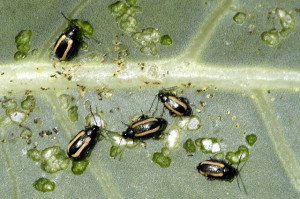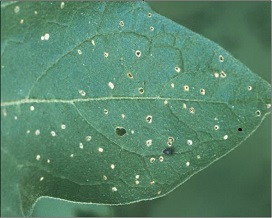A flea beetle can walk, jump and fly, and their size and speed mean that they’re generally pretty stealthy. Unfortunately, they also target almost all vegetable crops and they really wreak havoc on young transplants . You’ll want to know how to look for signs of flea beetle damage, as well as how to prevent and destroy an infestation.
Getting to know flea beetles
Flea beetles are much smaller than most other leaf beetles, and have characteristically enlarged hindlegs- the secret behind their quick-hopping ability. The adults overwinter in garden “leaf litter” and in nearby wooded areas, and become active in spring. If you see these dark, shiny beetles (often with curved white or yellow stripes on both sides of their back) that jump away at the slightest disturbance, you’ve found flea beetles.
If you spot these bugs, check nearby plant foliage for signs of damage. Flea beetles are known for chewing into the foliage, leaving tiny “shot-holes.” Adult flea beetles lay eggs in cracks in the soil around the plants’ base. The larvae emerge usually in a week’s time and start to feed on the roots. Pupae stay in the ground for a period of 7-9 days before the adult beetles emerge, completing the cycle. There can be 2 to 3 generations depending on what zone you are in.

Flea beetles are small, black beetles, often with yellow striping.
Photo copyright James Lindsey at Ecology of Commanster via Wikimedia.
Preventive and offensive measures
- The simplest way of controlling flea beetles is to deny them the space to overwinter. Remove all garden waste and weeds and dispose it safely. A pre-emergent weed control is wonderful way of preventing weed growth.
- You can schedule planting your flower and vegetables such that the seedlings emerge and transplants are planted while the flea beetles are largely inactive.
- Floating row covers are ideal for screening developing seedlings, keeping flea beetles at bay. Our Super-Light Insect Barriers are a great help for crops that do not require pollination. The translucent poly-propylene material of the barrier lets in 95% of sunlight without any significant heat buildup so it can be left on all summer to keep away flea beetles and other hungry pests.
- Introduce beneficial nematodes. Grub-Away® Nematodes can eliminate almost all kinds of soil dwelling pests (ninja-pests included) without damaging the soil or environment.
- Our Pyola Insect Spray is an environmentally-friendly, easy to use formula that kills many s insect pests, including aphids, gnats, worms, mites and of course, flea beetles. Bulls-Eye Bioinsecticde is another multi-pest spray, based on the active ingredient Spinosad, that will control flea beetles.

